It was the morning of May 1st, International Labour Day. Right I thought, let’s raise a cheer for the Workers of the World; I have worked in a few countries where that one is still celebrated! Then again, thinking more selfishly now of matters a bit closer to home, it was also the first day of what should be the loveliest month of spring and I really wanted to go dry fly fishing. What else would I do in May? And yet, when I put my nose out of the door I found the car was covered with frost. Somehow this seemed rather discouraging, although in fact the last 30 mornings had been just about the same. So I lingered over breakfast, chatted to the fishery owner when I got to the upper Monnow and so didn’t reach the river with rod in hand until nearly 11 o’clock. Nothing much was hatching yet, but I slid into the water near the bottom bridge and made my way upstream. I had an 8 foot rod made up with a small Parachute Adams and if nothing was to be seen rising, I was resigned to prospecting in the known likely places. And quite soon I did see a swirl in one likely place under an overhanging branch. I had a couple of shots to get the fly into the right spot, it disappeared and I struck, only to prick a decent trout which turned over with a flash and fled in panic. Perhaps I was too quick? Still, it was a start and I moved on to the next likely spot which is a deep hole in the bed rock with a current flowing into the head of it. Nothing was seen rising here, but I ran the fly in at the head of the pool and sure enough up came a really good fish which duly sucked it down. This time I was a little slower in striking and as a result I netted a fine and beautifully coloured trout, fat and in good condition for the time of year. It measured 16 inches, a very nice one for the upper Monnow. One more fish, a 14 incher this time, came from beside some alder roots; this too was seen rising.
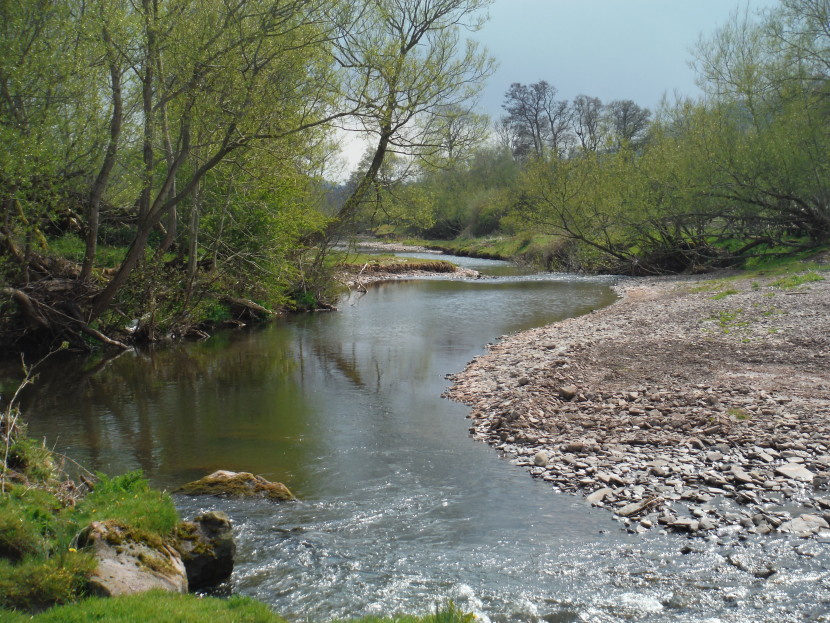 Spring on the upper Monnow
Spring on the upper Monnow 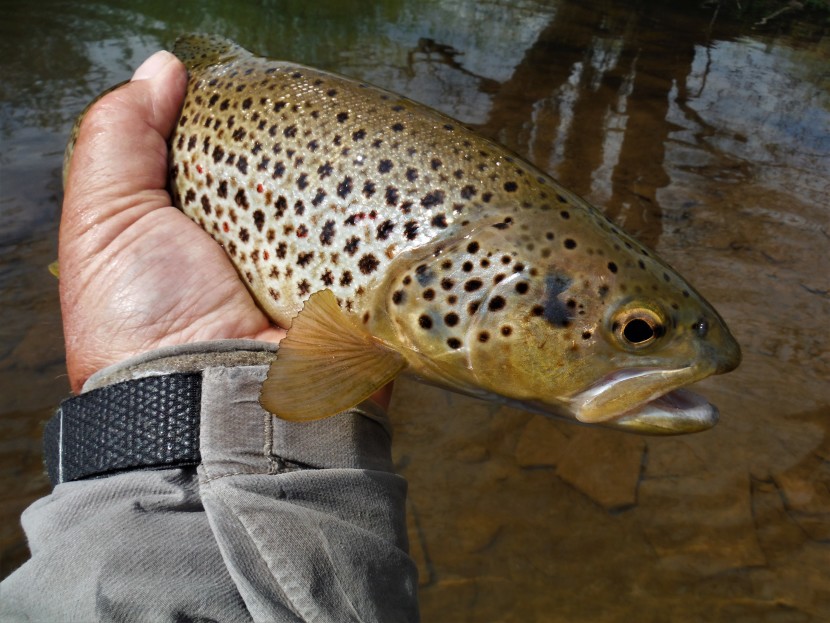 May trout from the Monnow
May trout from the Monnow 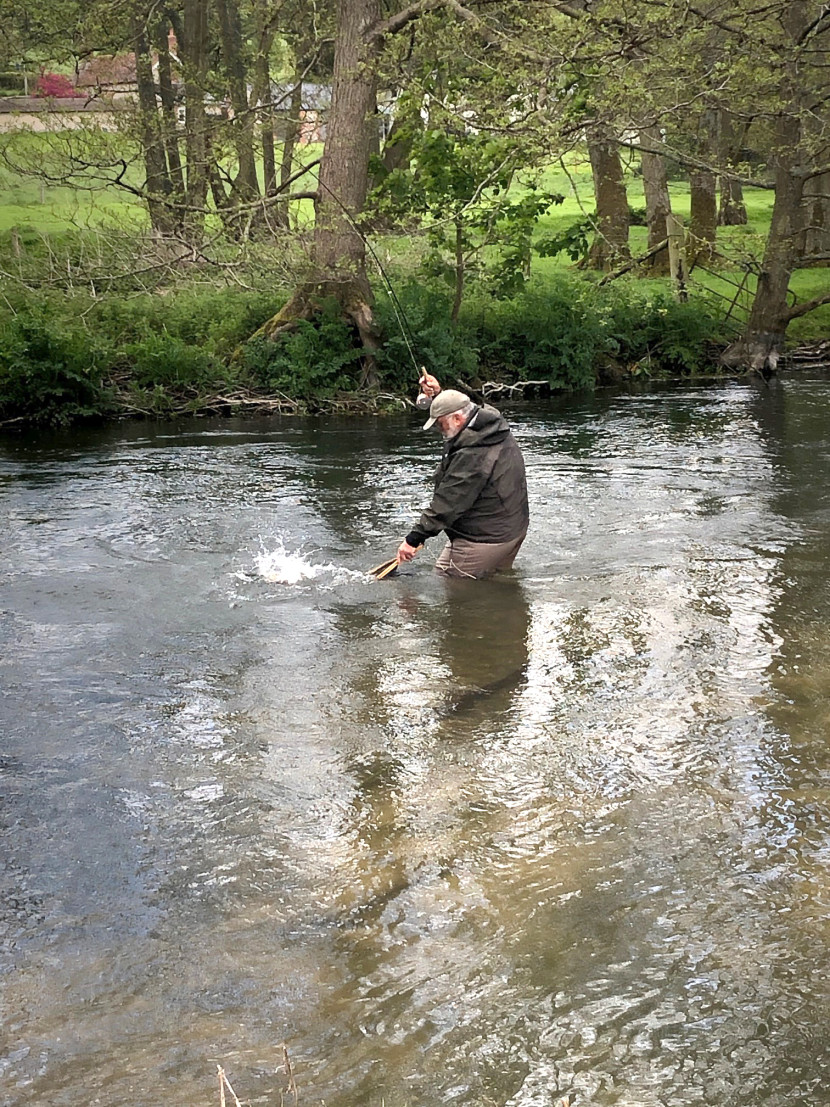 A good one from a shallow run
A good one from a shallow run I was pleased with that brace but then came a fair walk of the best part of a mile upstream to explore some new water where the river runs shallow over gravel. It was still really quite cold, maybe 7 or 8 degrees, less when the sun went behind a cloud, but all sorts of flies were now hatching. I spotted some large dark olives, medium olives, iron blues (very encouraging that), and some sort of stone fly – possibly the February Red?
There were also some hawthorn flies hanging in the lee of a hedge. I think that insects are beginning to find the weather as confusing as we are; some are early, some are late, and some are on time. The day before, by one of the Forest brooks, believe it or not I saw a real mayfly, a large green drake, which must have been a good 2 or 3 weeks ahead of season. I presume she wandered around in vain looking for somebody to mate with.
I found myself wondering if the same thing happens to young people these days, faced as they are with so many choices about their own and other people’s sexuality? Who is going to do what and with which and to whom? But what would an old buffer like me know about it? In a few more years I expect that to save time everybody will have a card to hand out with their name, whether they liked playing with toy tractors or dolls as a child, gender selected from a drop-down menu, dress preferences, who they are attracted to, what equipment they have/had, how they want to be called and what bathroom they want to use. What fun it will all be! It makes memories of my youthful adventures seem dull by comparison.
But as is so often the case I digress. Meanwhile, for a few minutes on this shallow section of the Monnow trout were getting excited, literally throwing themselves out of the water at insects on occasion. I wasted a bit of time trying an iron blue imitation, and then manage to miss two more fish. At which point a steady shower began, so that I pulled up the hood of my jacket, and then the rain turned to sleet and finally it actually snowed for a while. When it stopped, the flies seemed to have gone and you wouldn’t think there was a fish in the river. A lot of days have been like that this spring.
The black clouds which had been around for a while finally let go with a vengeance on 3rd May and we had an evening of really heavy and cold rain. The long drought was broken at last. The Cambrian Mountains and the Beacons must have received an extra heavy dose through the night, because a short-lived, but sharp rise began to run down both rivers, although some of the tributaries were unaffected.
For the Usk this was an event of not much more than 30 hours from top to bottom, but the plug of high water, not as dirty as I had expected, took over 48 hours to ripple down the Wye. We waited to see if this, together with recent high tides, might be enough to tempt some salmon upstream. Sure enough, shortly after there were fresh fish caught at Cabalva on the middle Wye and Trostrey on the lower Usk, with more to follow, from Hereford and Ross, and from Chainbridge on the Usk. This should have gone some way to cheering up the salmon anglers.
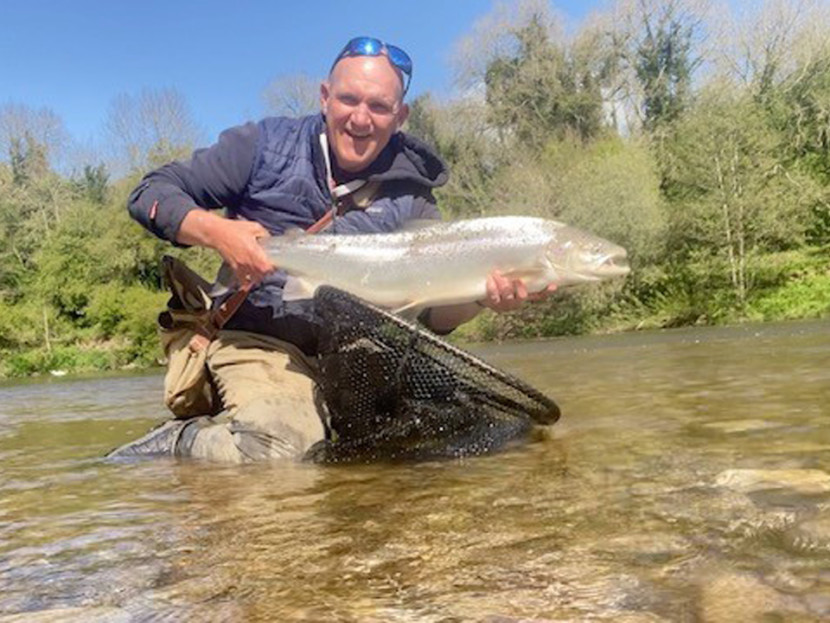 Cabalva fish - Dave Roberts
Cabalva fish - Dave Roberts 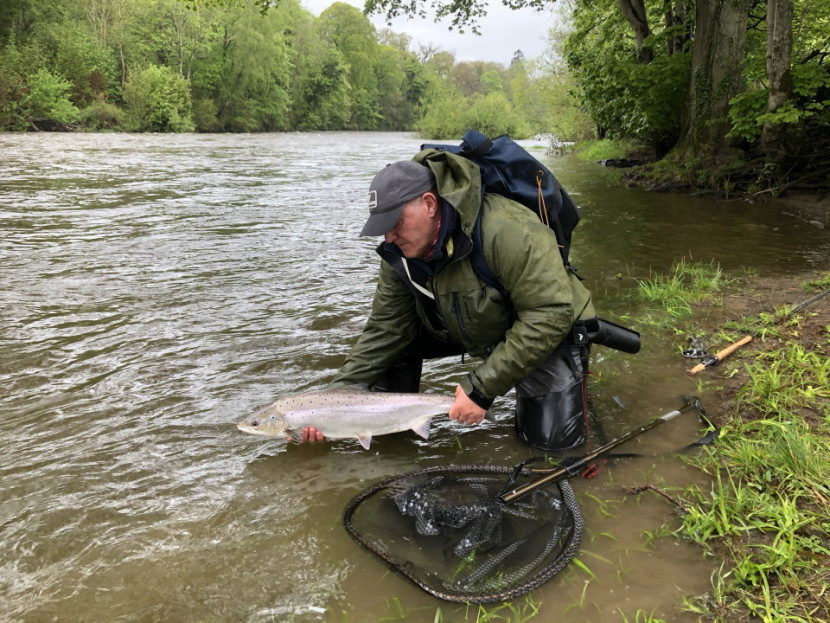 High water on the Rock Pool, Rectory - AW from Kidderminster
High water on the Rock Pool, Rectory - AW from Kidderminster On the 4th, CT from Cardiff took a dozen trout to 14 inches from the Monnow’s Honddu tributary at Lower Henllan, using a nymph fished under a dry fly. JA from Leominster fished the Arrow at Hergest Court, where the WUF habitat team were also busy, and caught 9 trout to 11 inches. Some great catches of trout were reported in the next few days. AA from Crickhowell with a friend had a remarkable day at Ashford House, taking 14 on dry flies during an extended large brook dun hatch which went on through the afternoon. The pictures tell the story. On the 7th Dave Collins of Herefordshire had 8 trout to 18 inches on the Upper Wye below Llanwrthwl Bridge. Seth from the Foundation was back at Ashford House with a friend the next day and they took 13 up to 2 pounds mostly on CDC emerger patterns. Rather typically of this strange spring, there was quite a potpourri of flies hatching and falling on the river: a few grannom (even now), olive uprights, black gnats, and a few yellow mays.
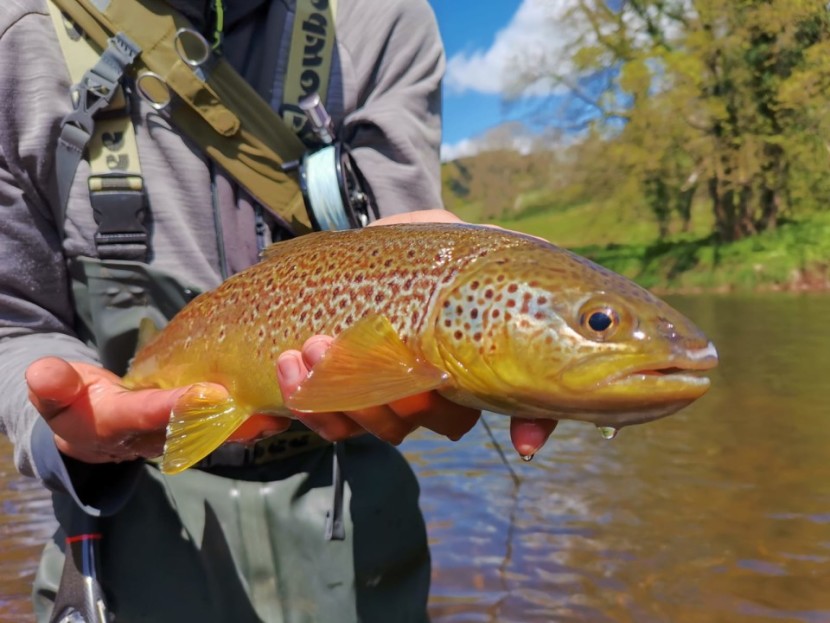 Ashford House trout - AA of Crickhowell
Ashford House trout - AA of Crickhowell 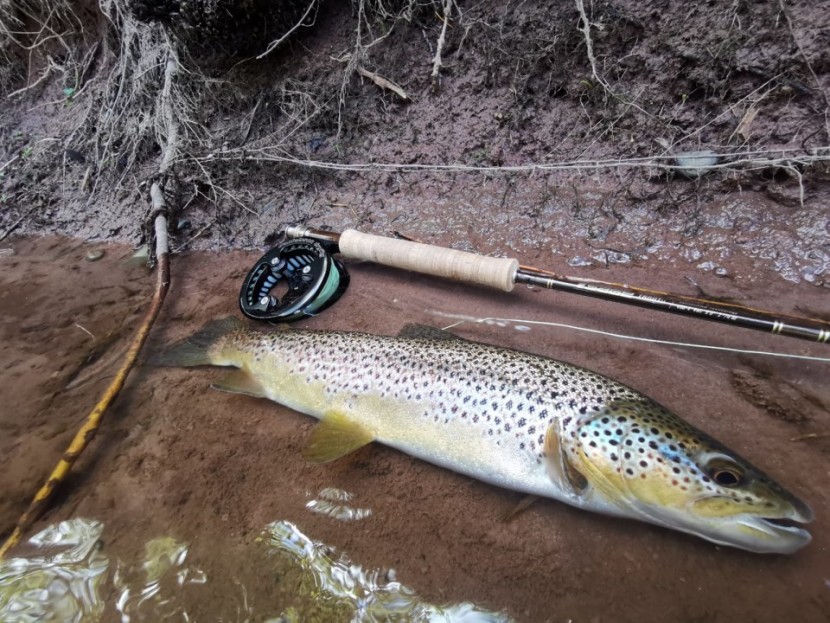 Another Ashford House trout - AA of Crickhowell
Another Ashford House trout - AA of Crickhowell 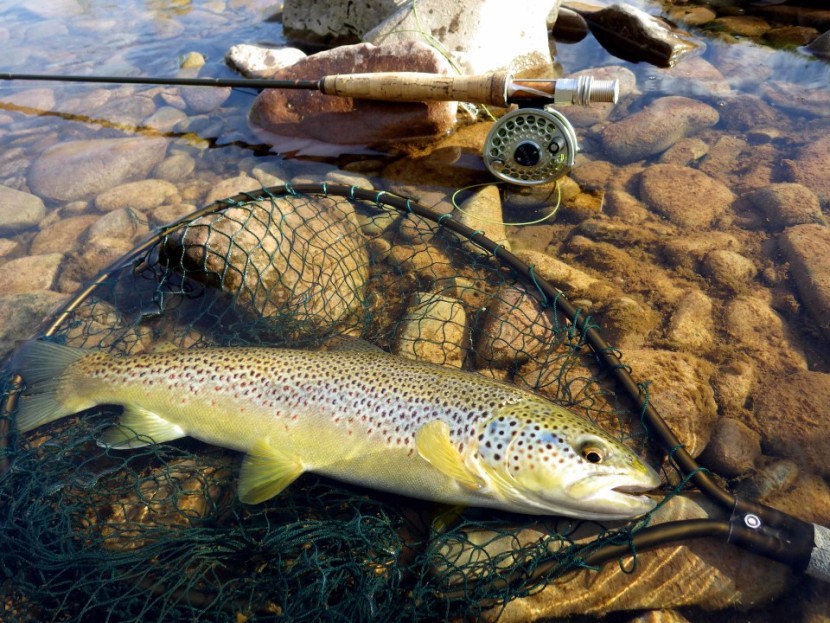 Ashford House trout - SJ of Herefordshire
Ashford House trout - SJ of Herefordshire 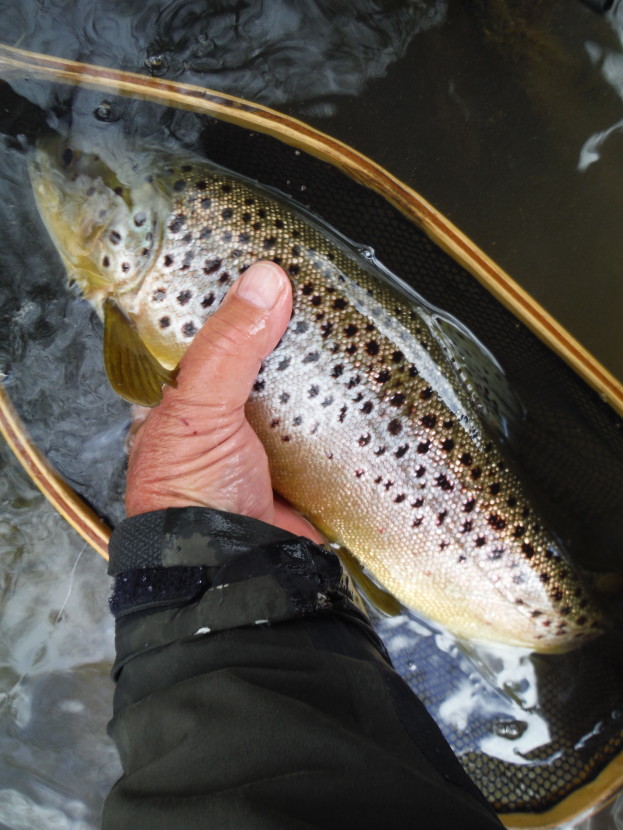 Avon trout
Avon trout 8th May marked a big change with really intense rain beginning in the early hours and continuing throughout the day with an associated increase in temperature. The weather was now coming from the Atlantic and by mid-morning our upper rivers were in full muddy flood. We were flooded off the Usk at Brecon in the most spectacular fashion. With the initial exception of the Lugg and Arrow, the tributaries were equally high. For now it seemed, there would be nothing much to do on our border rivers. Planned appointments had to be delayed. I went shooting on the Sunday and couldn’t help noticing how many hawthorn flies were sheltering from the wind, hovering in the lee of trees. St Mark’s day, 26th April, is supposed to be their signal for hatching. David Burren saved the day on the 10th by inviting me down to fish as his guest on the Wiltshire Avon. David has creaky knees and my back was acting up a bit, so we felt like a couple of old crocks, but that never hindered David, who loves his fishing almost more than anything, so we sped in his Jaguar across the Wessex downs to the Great Plain of Salisbury and the little village of Upper Woodford.
The Avon valley already looked green and lush, the spring seeming distinctly advanced compared to our border country. Nevertheless, this was an early trip to the chalk streams for us. When permitted and without quarantine restrictions, we reckon to start on the Usk on 3rd March, with a definite chance in the middle of the day for a fish or two on the dry fly. In Wiltshire they tend to reckon 1st May as quite early enough to go fishing, and there is generally no rush about it at that. Heale keeper Peter Major had been slightly dubious about our trip, remarking that the river was high without much sign of rising fish. There was a certain colour in it too and the wind in the valley was cold and strong. It would be wrong to imagine that all chalk streams are quite impervious to heavy rainfall. The Avon is something of a hybrid, because several of the sources are on sandstone rather than filtered through chalk, so rain does have some effect. Still, the river looked eminently fishable, even if strong and dark without sight of the bottom in the deeper sections. I started for once with a nymph above the hatches, and after about 10 minutes a fish swirled upstream just under the surface. It took the Tungsten Hare’s Ear dropped above it on the third attempt and so we had the first of the day. After that we switched to dry flies, in my case a size 14 Parachute Adams. There were just a few olives trickling off in corners where the cold wind was not too strong and if you could find the very occasional rising fish, you had a good chance of catching it. Generally the faster, shallower sections below hatches were more productive. By the standards of the Heale fishery it was a hard day’s work, but we ended with a baker’s dozen of trout between us, together with a few accidental grayling.
However the fishing goes, Heale is always a wonderful place to spend the day, simply because of the scenery. Nearly all the valley land is under sheep with occasional villages of mellow brick cottages roofed with thatch. Open farming is reserved for the great fields of the Plain high above, a place for hares and larks and long views of distant skies. Now I am told the great bustard is being reintroduced from Russia. Things are still done traditionally down in the valley, despite the judicious use of modern power tools and machinery. Hatches and carriers are maintained and you can understand the careful calculations which must have been made by the forebears of these modern Wiltshire countrymen about water levels and the flooding of pastures. Trees are still coppiced and most of the willows in this part of the valley have just been pollarded. Almost anywhere else, including on our Welsh border streams, all that you can see is where willows were once pollarded, a good century ago when there was still a use for the cuttings.
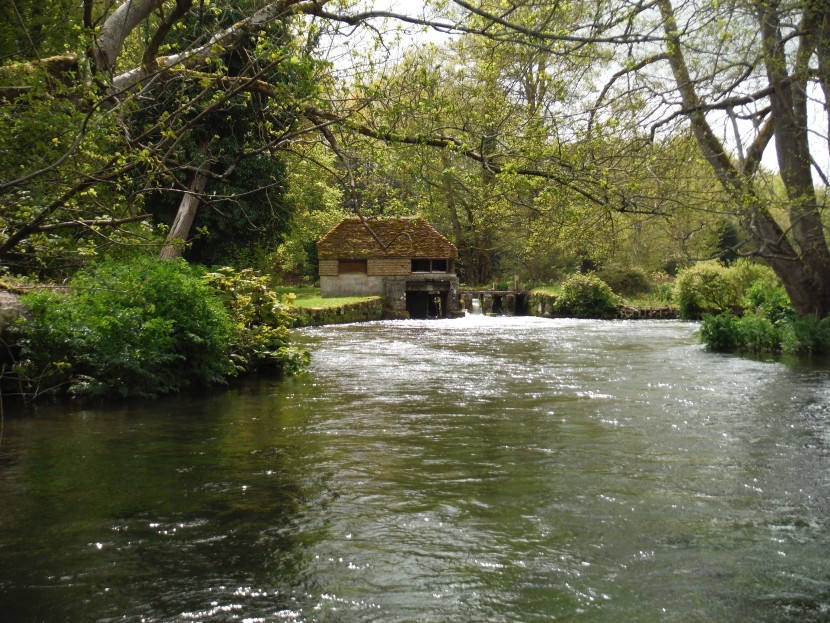 Avon hatch pool and a big flow
Avon hatch pool and a big flow 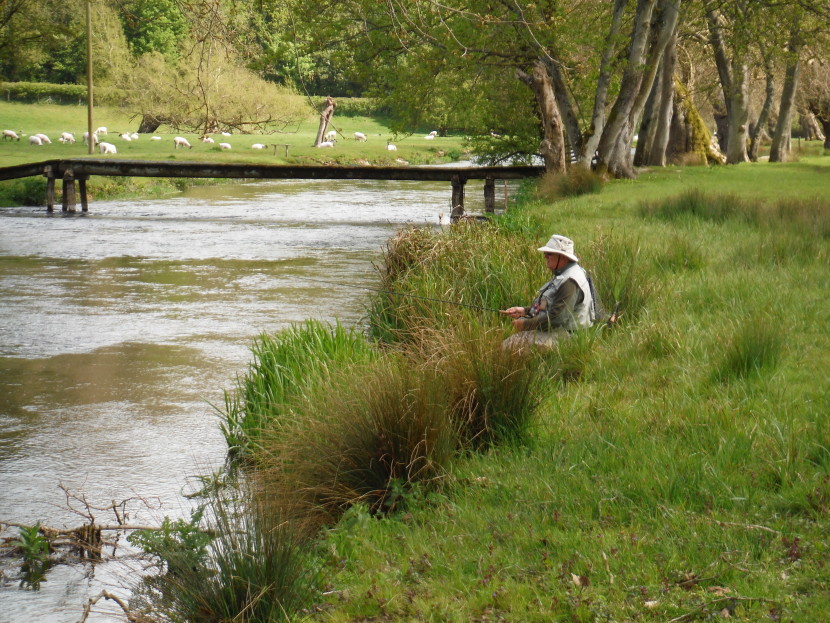 David Burren keeps a low profile on the Avon
David Burren keeps a low profile on the Avon 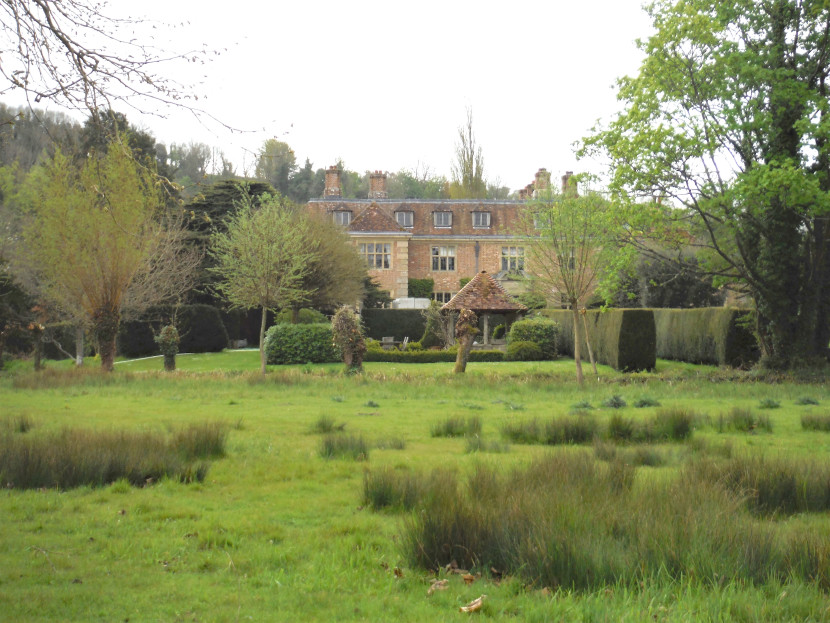 Heale House from the river
Heale House from the river On the 11th DR from Llanarth managed 7 trout including a large one from the Honddu at Lower Stanton. Next day LD from Swansea found the Usk fishable at Abercynrig and also took 7 fish, including specimens of 17 and 18 inches, mainly on dry flies. PD from Cheltenham had a brace of two pounders on dry fly from the same beat. DH from London had a trout of a kilogram (2.2 pounds) in a leash taken on dry fly from Penpont. AT of Weobley fished the Edw at Hergest on the 13th, caught five trout with a small nymph and was thrilled with the surroundings. It’s a great little tributary, the Edw, and usually manages to please.
But now the rain kept coming, day after day, and it was often difficult to find any river fishing at all. The typical day began with a little sunlight, then clouds would begin to build up, and ended with heavy rain before dark. This, falling on land now thoroughly soaked, kept the rivers topped up and made it very difficult to predict when levels would fall back. When it was not too muddy from the inlet stream I spent some time on our Forest Pool and enticed a few rainbows to the surface with Dennis Moss’ famous Chocolate Drop dry fly.
RM from Buckinghamshire found the Usk very high at Abercynrig on the 15th, but it was at least running clear for a while and he managed to catch 5 during an early afternoon hatch before more rain coloured the water again. Meanwhile RE from Northampton with a friend was fishing just upstream at Dinas and they took advantage of the same short window of clear water. They took 25 trout between them, including a lot of fish off the top during hatches.
A few salmon were taken from the upper Wye at this time, proof that by now some fish at least had run through. DJ from Evesham reported 6 trout on nymphs from Fenni Fach and a salmon jumped close to his position. Clearly they were also in the Usk above the Brecon weir.
 Hergest Court - JA from Leominster
Hergest Court - JA from Leominster 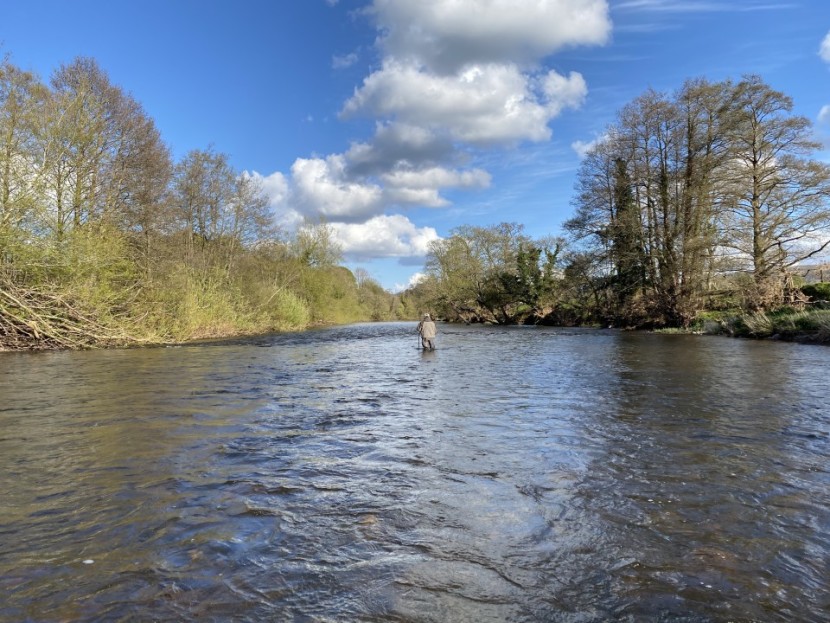 Abercynrig - PM from London
Abercynrig - PM from London 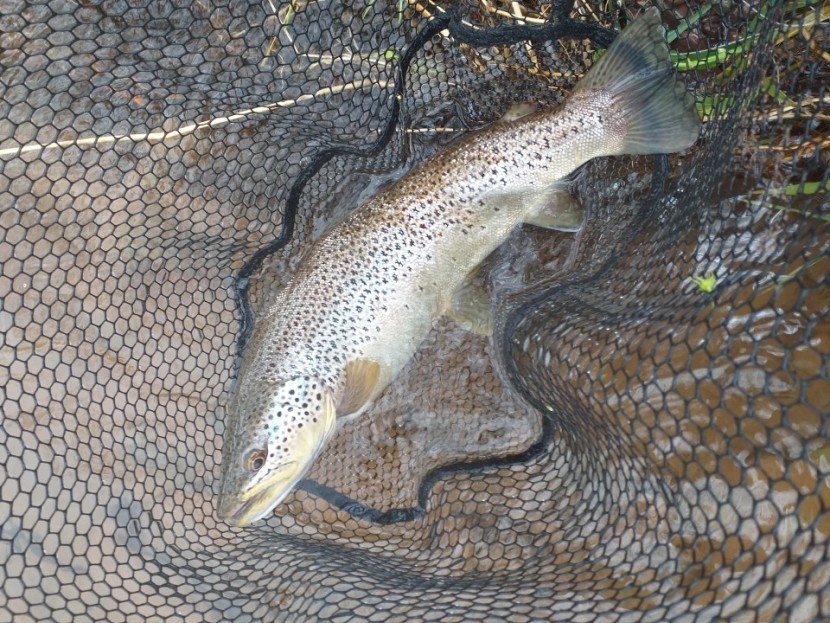 Abercynrig trout - RM from Buckinghamshire
Abercynrig trout - RM from Buckinghamshire 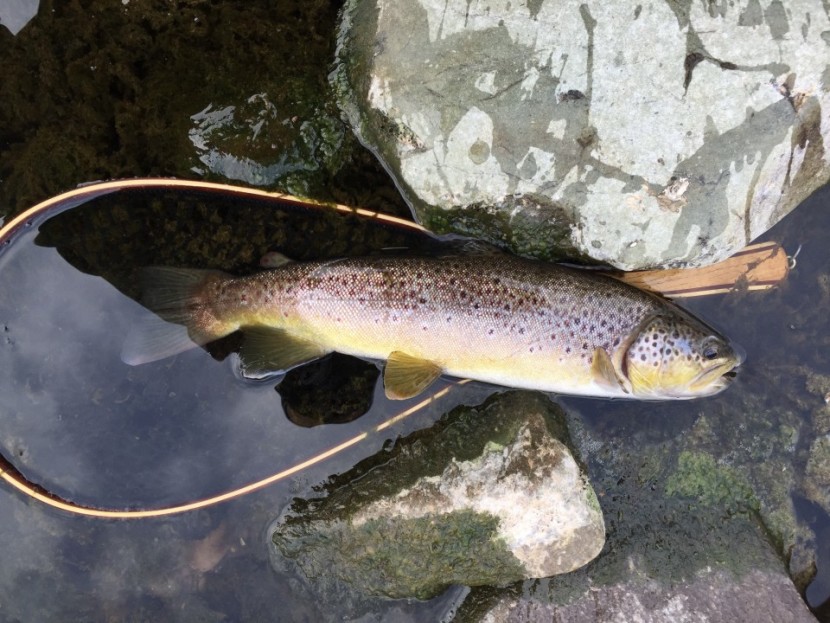 Dinas trout - BA from Gaydon
Dinas trout - BA from Gaydon 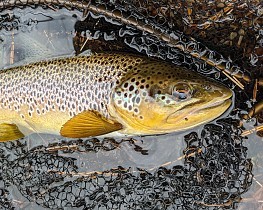 Pond Rhosrydd - CT of Cardiff
Pond Rhosrydd - CT of Cardiff Salmon anglers were coming to the interesting conclusion that, due to the extended period of high water, we find ourselves still in the spring period but with fish having run right through to the tops of both rivers. Writers like Augustus Grimble at the turn of the 20th century confirmed that this was normal enough in the golden years with springers to be caught from opening day in the upper pools, but in modern times it has become more and more unusual. We have become used to a situation where the top beats only really have a chance in the last week or so of the season. However there is another aspect to this apparent early run, which is that should a drought occur this summer, large fish trapped in small pools will become vulnerable to two legged predators in particular.
On the 16th TD from Pontypridd fished the Usk Reservoir for a trout and a perch and wanted to know: “Firstly, why is an evening ticket not available?” That’s a question worth asking, I suppose, but first is there any particular reason why an evening ticket should be available? It would be good to hear the argument. I note that the owners, Welsh Water, are already offering quite a range of ticket options. RD from Cardiff fished at Talybont Reservoir and had a dozen wild trout to 1.75 pounds. On the 18th MW from London fished the Usk at Penpont and managed a good brace on Partridge and Orange and Waterhen Bloa – it’s nice to hear about North Country spiders being used in Wales. BH from Oxford with a friend fished Pond Rhosrydd and reported a 20 inch wild brown trout in good condition. That sounds superb and I should point out that if 20 inches and in good condition, that would have weighed something over 3 pounds rather than 2. Pond Rhosrydd, which is trickle stocked with brownies by Aberystwyth AA, is one I don’t know – a good few miles off my patch - but the pictures look very atmospheric. ST from Salisbury with a friend booked Dinas and Abercynrig together and they accounted for 20 trout on dry flies. On the 19th IS from Dorchester with a friend had 10 trout from Dinas, while PD from Abingdon had a 2 pounder in a catch of 4 from Abercynrig, immediately below. A proper hooley of a gale was blowing on the 20th with a lot rain coming in from the Atlantic so that by the end of the day all our rivers flooded once again. Despite the storm, David Burren managed to fish the Avon at Heale again, seeking out sheltered corners. He reported that the mayfly have started and that he caught four trout to three pounds on a Monnow Gosling. The following week he had a dozen in conditions equally difficult. Again, a few mayflies were being sipped down in quiet places.
Otherwise, with the rivers flooded it was necessary to turn once more to still waters. Rob Evans tells me that Chew Valley Reservoir is fishing very well lately, with some really excellent over-wintered rainbows, mostly over 3 pounds, taken especially over areas like Roman Shallows. Teams of buzzers have worked as you might expect, as have traditional wet flies short-lined in front of the boat in a good chop. It’s nice to think of traditional flies like Kate Maclaren and Loch Ordie still earning their keep. Blagdon, as is often the case, has been rather more difficult. Once again, the future of fishing at Bristol Water Company reservoirs seems to be in question. The latest suggestion is that it should be run by a trust.
We had news from two more north Wales lakes, both of them unknown to me. On the 21st WH from Bristol reported a small sea trout from Llyn Coron on Anglesey. Now that sounded interesting; I am afraid I have never caught a sea trout in still water and I rather wish I had. The following day he fished Llyn Cwellyn in Snowdonia for 9 wild trout. This one also has a population of arctic char, although I am not sure how easy it is to make contact with rod and line. He warned that the car park, for which you must pay, is very busy with hikers. JH from Cheltenham reported an accident experienced during a windy day by Talybont Reservoir, resulting in a nymph stuck in an angler’s forehead. It could have been much worse and it formed a timely reminder to be careful. If you don’t wear prescription glasses, always wear some other form of eye protection. CT from Cardiff also fished at Pond Rhosrydd, which he found coloured, with the water risen about 18 inches, and with a very slippery access track. Nevertheless he managed five trout to 18 inches on lures.
Meanwhile NH from Truro, looking for some river fishing, wisely headed high up the Wye. At Upper Clochfaen he found the river high but clear and took a brace on a streamer. The following day he fished a falling flood on the Colonel’s Water of the Irfon and took another brace on 5mm tungsten nymphs. On the 23rd BB from Cambridge was brave enough to tackle a flooded and coloured Teme at Bucknell and found that he was unable to ford the river. Given that, due to the unusual underlying geology of this section, it is normally so shrunken by late spring as to be easy enough to cross gravel shallows without getting your knees wet, this unaccustomed flood must have been quite a sight. On the 25th KP from Cowbeech managed to take a very-creditable-in-the-circumstances 8 trout from the Irfon at Llanfechan, the river being too high to wade. He was using the duo method, then later the Reverend Powell’s Baby Sunfly, which is a traditional border pattern if ever there was one. On the 26th, with the Llanstephan gauge at 2ft 9 inches, LD from Hereford took an 8 pounds salmon with a blue tube fly from the Rock Pool of the Wye’s Rectory beat. NH of Truro was out again, this time on Dinas where he found the fish “hard on the bottom” but caught 11 trout to 2 pounds using heavy nymphs and a French leader.
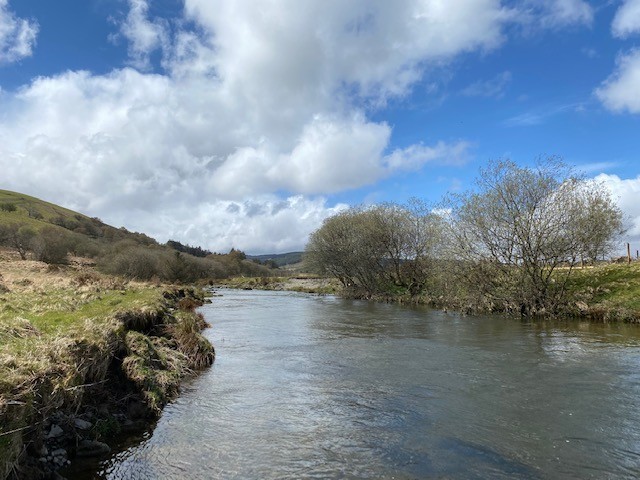 Top of the Wye at Clochfaen
Top of the Wye at Clochfaen 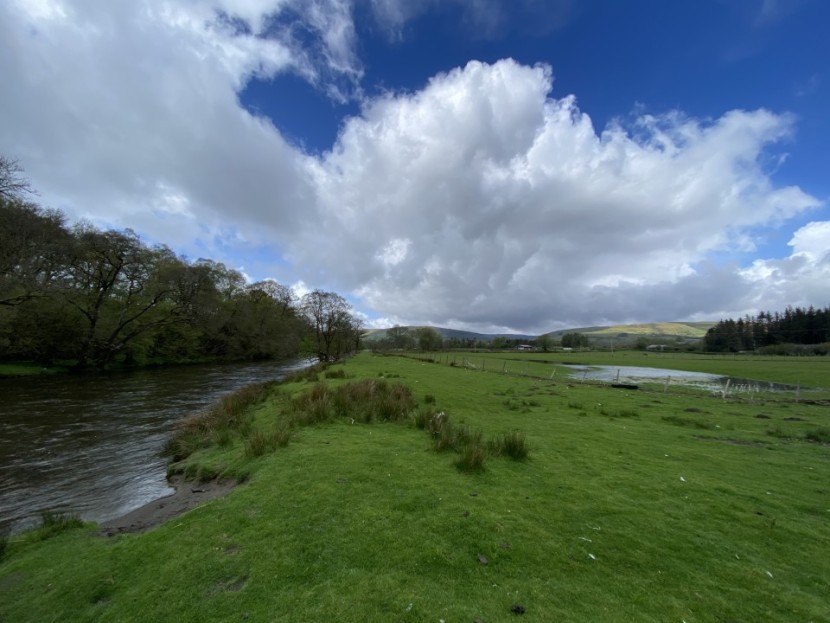 Flood dropping off the Colonel's Water - PD from Cheltenham
Flood dropping off the Colonel's Water - PD from Cheltenham May and this strange and rather late spring, came to an end with a bank holiday heat-wave, the rivers still quite full and a mini-bonanza of salmon catches on the upper Wye. Most of the Erwood beats had a few, and some quite a few. Meanwhile the mayfly season on tributaries like the Lugg and the Arrow was just on the cusp. By that I mean that the big white flies were already up and about during the afternoons, but the trout were still in the process of learning that they could actually be eaten. Nevertheless some good fish were starting to risen at beats like Lyepole and Whittern, and I saw mayfly on the Teme and Wiltshire Avon also.
On the 27th DA from Warsash, Southhampton reported 10 trout taken from Beat One of the Tawe on a Tenkara rod. JW from Castle Combe reported something a little strange from the Honddu at Lower Stanton, in that a second angler was following him up the beat. That shouldn’t happen under our rules for Wild Streams. The following day, SB from Reading reported 8 trout from Ty Newydd, ME from Shipton on Stour had a dozen from 8 to 11 inches at Hergest Court and JJ from Tonypandy had a large catch at Fenni Fach on the Usk, mainly using a French leader and nymphs. On the 30th JA from Leominster had 13 from the Edw at Cregrina (I thought it was only my neighbours in the Forest of Dean who like to refer to their homes as Ponderosa) and SB from Leeds with a friend had 19 from the Tees at the Raby Estate. On the last day of the month BP from Pembridge had 13 trout on nymphs from the Ithon at Llandewi and noted an injured out of season grayling. AR from Llanelli reported 11 from Hergest Court while JL from London with a friend had just 4 trout from the Usk at Ashford House. However, these measured 17 inches, 16 inches, 16 inches and 14 inches - a fine catch in my book. Finally, SO from Bicester fishing at Abercynrig reported a single very big trout of 1.25 kg taken on a wet Blue Dun Hackle.
While we are all busy gauge watching – and what else was there to do during this month of floods – I should note that there is a problem with that handy Shoothill Gauges site which forms a link between the Foundation’s webcam page and the EA and NRW water gauges. Using the Shoothill link, I can’t seem to get any reading later than 7th April. For now it seems necessary to go directly to the EA or NRW sites if the river you want is not covered by the WUF webcams, and then follow their totally different English and Welsh systems to get the reading you want. Don’t you just love devolution?
As far as anglers and many others in our area straddling two nations are concerned, the English Environment Agency and Natural Resources Wales are currently facing a double test. There are two cases of serious infringements of environmental regulations, for both of which we are expecting to see prosecutions and the due process of law. One is the pollution by slurry several years ago of the Llynfi tributary of the Wye, which resulted in a major fish and invertebrate kill. The other is the deliberate damage last year to the Lugg at Kingsland. This resulted in 1.5 km of a superb border stream supporting many wildlife species being dug out by bulldozers to create a sterile drainage canal.
Not wishing to prejudice anticipated prosecutions, I have not written too much about either of these matters so far. After the initial reaction, the Wye and Usk Foundation has also been deliberately silent, for the same reason. I appreciate that the proceedings of the Law have always been a slow business. However, it is very important that neither of these matters is glossed over. The fact is that while many or most farmers and landowners are reliable guardians of the environment, anybody who works in the countryside gets to know that some of them are very definitely not. In those cases, merely giving advice does not get the job done. There is a distinct risk that if flagrant breaches of environmental regulations go unpunished, others will be tempted to ignore the law also. I would suggest this is already happening; the breaches, large or small, accidental or deliberate, seem to increase year on year. This is not just a matter of whether the EA and NRW are adequately funded or not; it is a matter of what policies they are applying and how they react to incidents. In England, the successful prosecution of Thames Water and an appropriate 20 million pound fine for continually polluting the River Thame was a breath of fresh air. I do not believe that any action on that scale has occurred yet in Wales. We need to see now that our appointed watch-dogs have teeth and are prepared to use them. They are, after all, prompt enough to prosecute anglers found fishing without the appropriate EA licence, which forms part of their own income. Let us now see their reaction to serious damage to the environment. Otherwise, I am afraid that not only their budgets and management but their purpose and existence will be called into question. This might be the time for a completely new approach to protecting our waterways and our countryside?
Which leads me on to remarks made recently about NRW’s decisions and actions by Martin Morgan, Secretary of the Black Rock Lave Heritage Fishery. The Black Rock lave netters, who work under the motorway crossings and are just about the last of the Severn estuary’s commercial fishermen, are now being denied permission to take five – yes, just five – salmon per year on the basis that this would “negatively impact populations which are already threatened.” Instead, NRW wants the lave netters to change to catch and release. Mr Morgan states that this would be a pointless change which would make next to no difference to stocks. He claims, although I would contest it, that catch and release sport fishing results in the death of around 20% of the salmon released. He also demands to know what action NRW is taking to protect salmon spawning grounds upstream and that they should “put their own house in order.” Personally, I think an argument between sports and commercial fishermen in this case would be pointless. The two activities are inherently different. I support catch and release sport fishing, which is and always was done for the thrill of catching a salmon. Lave netting, which has always been done as a commercial activity and is necessarily carried out with coarse knotted mesh nets, does not lend itself to catch and release. I think I’m with Mr Morgan on this one; let the lave netters have their five for the market and keep the tradition alive. NRW tends to be unduly rigid in making rules for both anglers and commercial fishers, but surprisingly limp when dealing with farmers and landowners.
The restaurant owner Rick Stein and our local Severn and Wye Smokery at Chaxhill (soon to be moved to Lydney Docks) had a bit of a run-in with the trading standards authorities recently. The problem was that the packaging of smoked salmon sold at Mr Stein’s online shop was said to be misleading. The label described the smokery “…on the edge of the Forest of Dean between two of England’s most celebrated salmon rivers. It is there that they practice the old-fashioned art of smoking only the highest quality fish and meat.” Ignoring for now the description of the Wye as an English river, a definition which by itself might open up a can of worms, the fact is that the salmon in question came from a farm in the Faroe Islands. The Chaxhill Smokery (which does indeed make a very nice product) buys salmon and eels from many different sources. However, clearly there was a risk that farmed salmon could be mistaken for wild salmon and Mr Stein has agreed to alter the packaging. It does seem to me to be important that the public understands whether it is buying farmed or wild salmon, where it comes from, and what the implication of their choice might be. Meanwhile I have a moral dilemma, because my daughter absolutely adores smoked salmon. You can blame me for this, because when she was a little girl I introduced her to a home smoked Blagdon brownie served with mayonnaise and salad. I haven’t yet had the heart to tell her that she shouldn’t eat wild Atlantic salmon because they are becoming too rare, and she shouldn’t eat farmed salmon because farming at sea damages the runs of wild salmon.
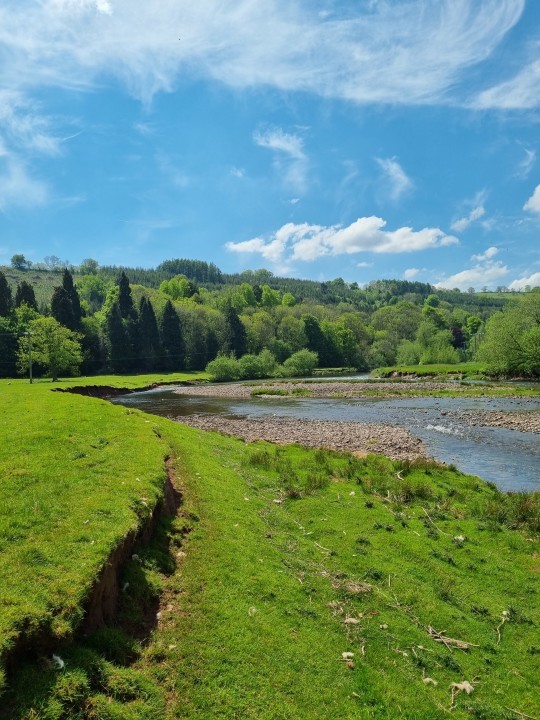 Dinas - SK from Thame
Dinas - SK from Thame I have been having some thoughts lately, come to some conclusions even, about breathable chest waders and boots. The prices quoted here are from Sportfish at Winforton. I decided quite a while ago that, provided you didn’t actually walk them into barbed wire, the bottom of the range Vision range (around 150 pounds for the old Vision Keepers) were in both the long and short term better value than the famous Simms G3 Guide waders (currently around 600 pounds). The cheap Vision waders were light to wear, easy to take on and off, and lasted a surprisingly long time. You could buy several of them for the price of one set of G3s, let alone G4s.
However, the Vision waders would usually be offered with a cheap set of Vision boots as a two in one deal, and the Vision boots were not so good. I normally found the uppers would rot away after only a couple of months’ hard use. For boots, I was convinced for a long time it was still necessary to bite the bullet and pay out for the Simms G3 boots made from waterproof leather (currently 249 pounds), because armed with felt soles and Hardbite studs, nothing else on the market would compare. However, I think I may have been wrong about that. By some mistake, last time I bought boots, I bought the Simms Freestone version (currently 178.99). These are entirely synthetic and they have been brilliant! The pair I have seem to go on and on, although eventually they will have to be retired if only because most of the felt is worn down – I never had any luck with resoling.
Which brings me to another idea. Currently you can still buy cheap Vision waders, the Atom at 179.99 and the Koski at 249 pounds. However, Simms are now competing further towards this end of the market with their Freestone model waders at 349 pounds. I wonder how good they are, or are we still paying extra money for a famous brand? I also note that Sportfish are offering a two for one deal on these together with a set of Freestone boots for only an extra 80 pounds, making a total of 429 pounds. That might turn out to be quite a good buy and certainly competes with a set of Vision Koski waders plus full price Simms Freestone boots. Alternatively of course, you could just opt for a pair of strong rubber boot-foot waders from Vasstek (98.99) which are easy to put on and easy to repair, I wear mine a lot and you would be surprised to know how many regular anglers do.
One other point about waders concerns an argument which goes back a long way. AH Chaytor described it thus in 1910: “Great controversy rages in the smoking rooms of fishing inns as to whether you should or should not wear a strap when wading in dangerous waters.” Oh my, what a lovely description! What a wonderful world in which we still had fishing inns and smoking rooms in them too! Well, I do wear a strap/belt, although I think I’m a bit old for wading in dangerous waters. I’m also a bit old for the demonstration Hugh Falkus famously made, flinging himself into deep water in front of the camera. For all that, I’m convinced that whether you have a belt or not makes no difference at all and that the small amount of air trapped in your waders, rather than turning you upside down and drowning you, should help to keep you afloat while lying on your back until you fetch up on gravel shallows and can crawl out. It would be a mistake to try to haul yourself up a vertical bank or an overhanging tree branch with your waders full of water; you won’t get out and the weight of the trapped water will exhaust you very quickly. Best of all, don’t get carried away in the first place, so act your age and avoid dangerous waters and currents.
May I take an opportunity to request, as I do quite regularly, that you keep the fishing reports coming? There is an element of obligation here, as fishery owners and the Foundation do need to know what was caught…or what wasn’t. Don’t be too concerned about blanks – salmon anglers know all too well about those – because blanks also give us valuable information. If every day was a triumph, I can promise you that we would soon become bored with this sport, intriguing and sometimes frustrating as it is. If you are new to the sport, I can also promise you that the days of triumph will come sooner or later.
Some of us enjoy to write and others don’t, but please regard basic details of the catch as a minimum requirement. Numbers and species caught should be quite straight-forward, but I should also raise again the slightly delicate subject of what Arthur Ransome once called “the elasticity of fish.” If you are lucky enough to catch a specimen (it happens to everybody sooner or later), do take a moment to measure it against your net, your rod handle or your staff, and then in the report give us the number of inches … or centimetres if you are of the metric persuasion. It is less common nowadays for trout and grayling, but a few people have scales in the handle of their landing net, in which case record the weight for us – just as good. And without wishing to seem unkind, words and phrases like “nudging,” “getting on for,” “must have been,” “pushing” and “about” are all estimates, possibly hopeful ones, but not measurements. If you caught a good fish, tell us what it measured. If you did not measure or weigh it, just tell us you caught a big one and we will rejoice with you in your success!
It’s my job to try to summarise the reports, but I must say the reading part of the task is a very pleasant one. If you can let us know more about the day, conditions of the water, a reminder of what the wind and weather were doing, hatching insects or rising fish encountered, you might be surprised to learn how many readers will be grateful for the information. There are so many extra things which make a report interesting: some of them delightful such as sightings of an unusual bird or an otter; some of them less pleasing, such as problems with poachers. Now and again we come across a real gem, and as an example I hope JT from High Wycombe will not mind my reproducing what he wrote for us some five years ago about the Monnow at Skenfrith:
J. T. from High Wycombe
Tuesday 3 May 2016
Area:Monnow
Beat:Skenfrith
Fishing:Trout (River)
No. of Anglers:1
I don't mean to abuse the catch return system but I thought other anglers, as they fish the Skenfrith beat of the Monnow, may appreciate some thoughts. We all have places where we learned to fish - a brook, a lake, a village pond. I was lucky enough to have this beat as my learning ground. My grandfather sub-let a day a week from about 1980 for 20 odd years, in addition to his salmon days on the Wye at Symonds Yat and Preston on Wye and he taught me to fish here. I clearly inherited the fishing genes from him as he was as obsessed as I was. There's a stretch of slower water more than half way down the beat, clear apart from reeds on one side, before you go through the woods. This was always my favourite spot. I can still remember him laying out a beautiful line with his cane rod to a rising fish during the mayfly. I also remember helping him over a stile, well into his eighties, when he turned to me sadly and admitted he was getting too old to go fishing any more. I remember most fish I caught here over 25 years. An early one, from the fast water in the top run after the bridge on a homemade worm fly, with the exhilarating flash of gold underwater and the glance behind me to my father. Or, the one on my own garish green creation, idly dibbled from a high flood-collapsed bank. The bottom run in front of the house was always a place where others seemed to catch fish but it was never somewhere I succeeded. I learned what craft I have on these waters and I still can walk every inch in my mind and I will until the day I die. I don't fish regularly here any more but will from time to time. When you fish from the beach, about a third of the way down, think of countless happy family picnics and where my own son caught his first trout. Its a very special place to me and I am thrilled that the WUF can make it available to so many others. PS - the fly that always did best for me (perhaps because it was the only one I could tie at the time and I was determined to use my own flies) was the Tups Indispensible. I'm never without one now....
Tight lines!
Oliver Burch
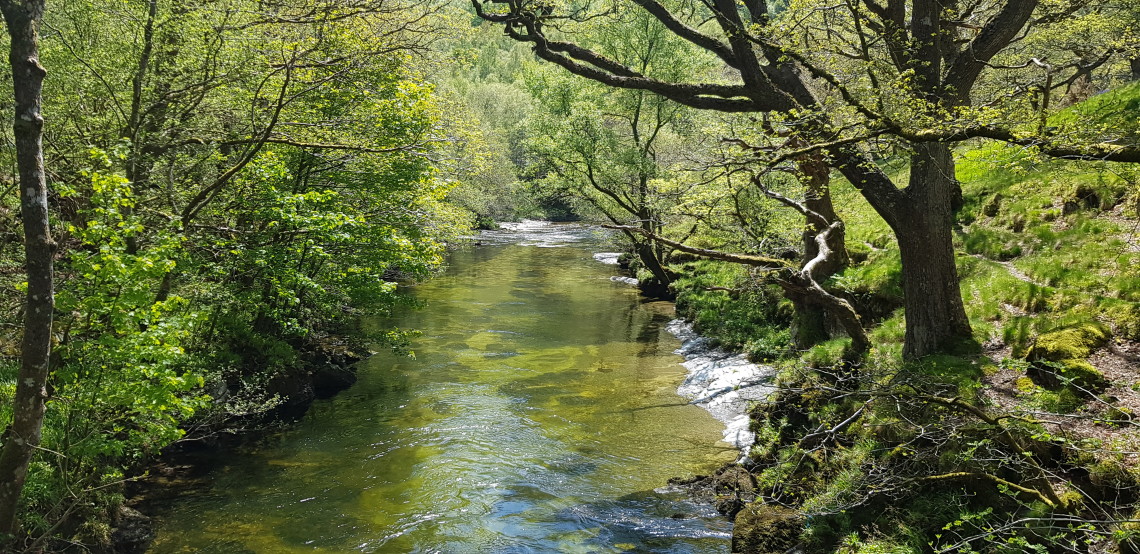 Upper Wye above Rhayader
Upper Wye above Rhayader